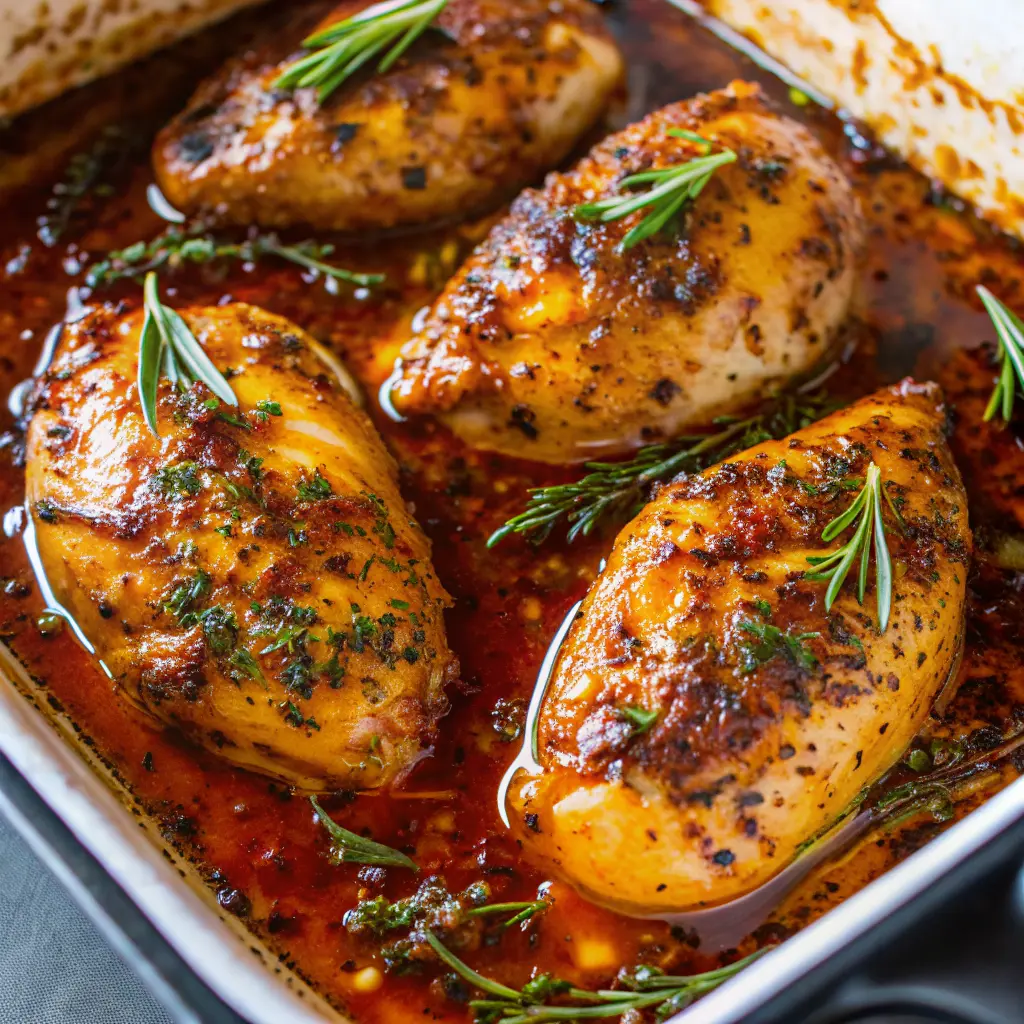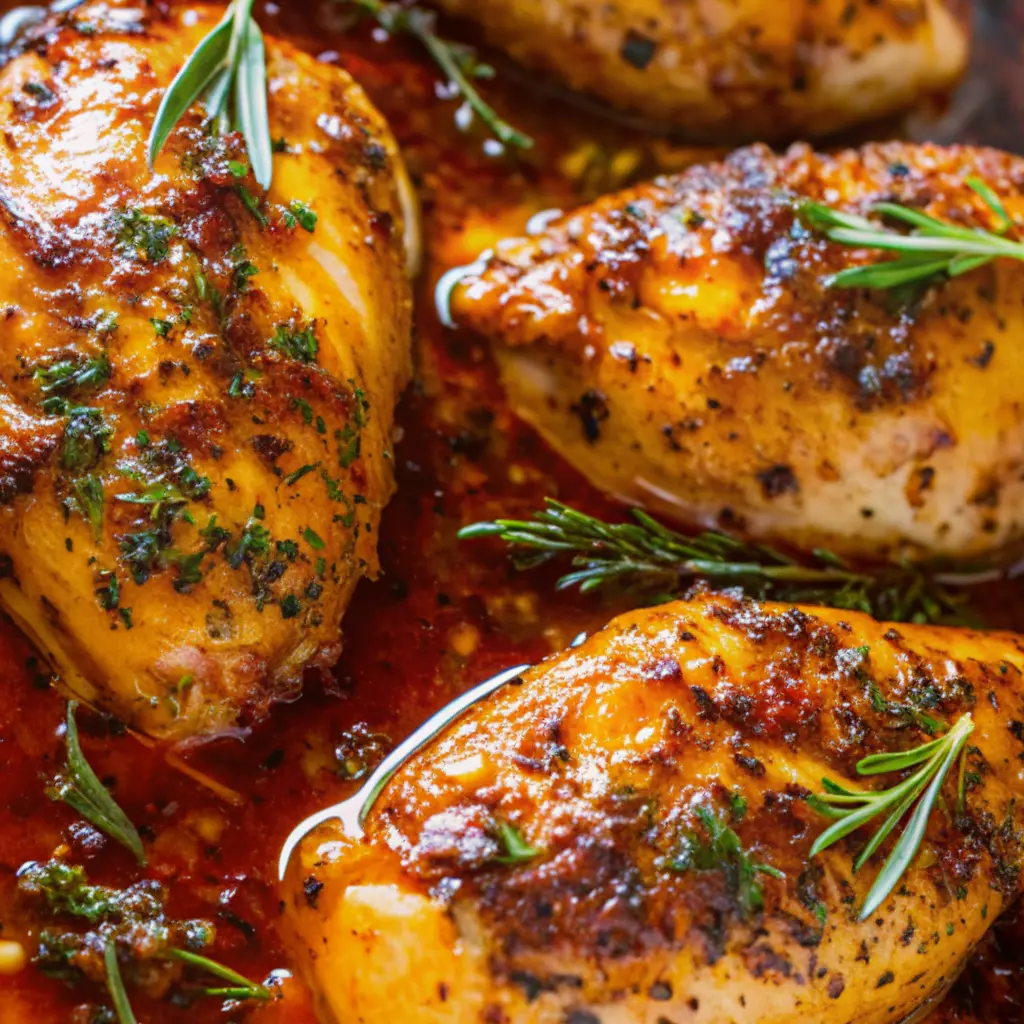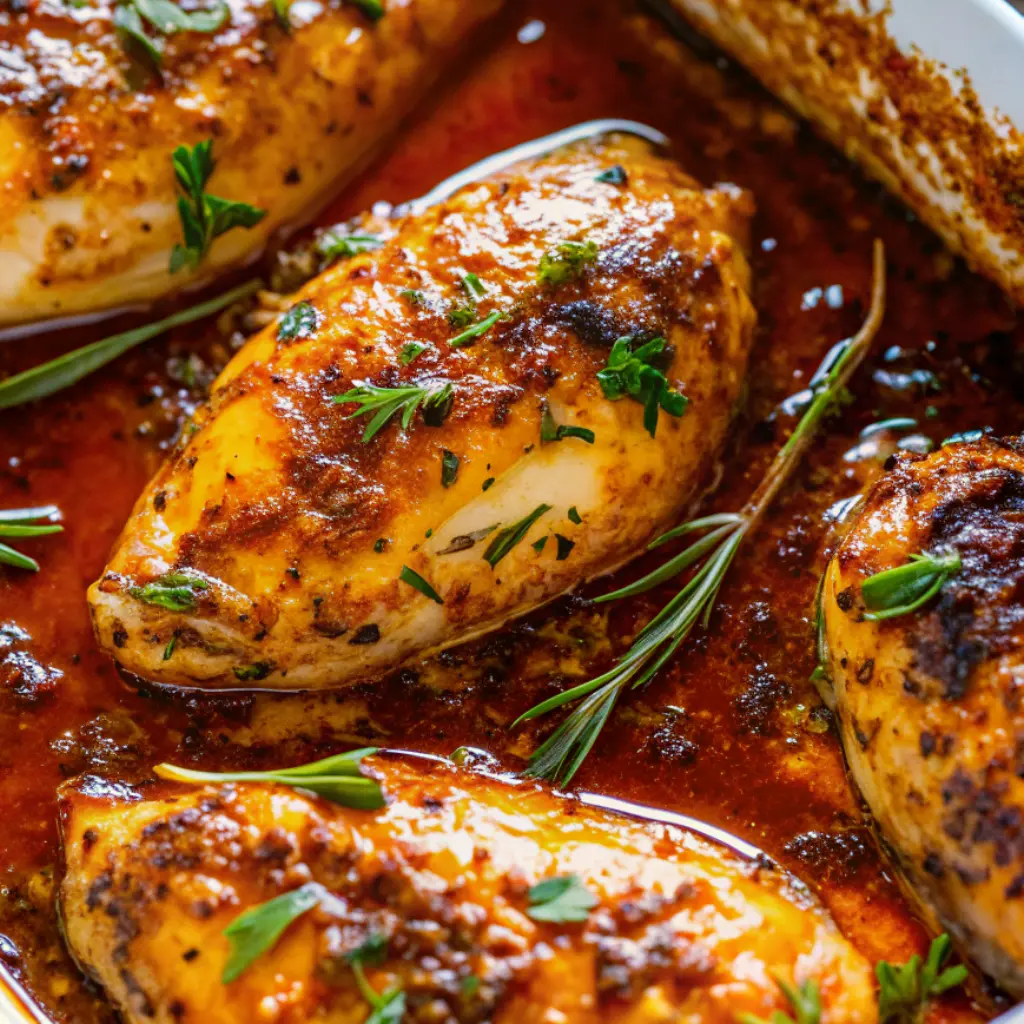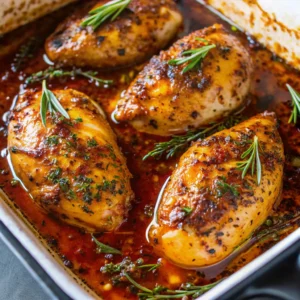It was a Wednesday night—one of those “nothing in the fridge, too tired to think” kind of nights—when Honey Mustard Chicken first entered my life. I had just come back from the longest parent-teacher meeting of the year, and the idea of dinner felt more like a chore than a joy. I opened the fridge, hoping some miracle would jump out at me. What I found was chicken thighs, a half-empty jar of Dijon mustard, and a forgotten bottle of honey hiding behind the pickles. The pantry had garlic and a shallot, which I nearly always keep stocked. That night, I threw them all together, said a little kitchen prayer, and hoped for the best. What came out of the oven was nothing short of magic—sweet, savory, a little tangy, and deeply comforting. Since then, this honey mustard chicken has become one of those recipes I return to when I need a dinner that feels easy but tastes like I really tried.

Why You’ll Love This Recipe:
- Ready in under an hour, mostly hands-off
- Made with simple pantry staples
- Naturally gluten-free
- Family-friendly and picky-eater approved
- Delicious as leftovers—some say even better the next day
- Easily customizable depending on what you have on hand
Ingredients You’ll Need:
Chicken thighs – I use bone-in, skin-on for maximum flavor and juiciness, but boneless thighs or even chicken breasts will work if that’s what you have. Just watch the cook time; breasts tend to dry out faster.
Dijon mustard – This is where the flavor gets its kick. Smooth Dijon brings a little heat without overwhelming the sweetness. I’ve used whole grain in a pinch, and it adds a nice texture too.
Honey – The star of the show. I prefer a mild, floral honey like clover or orange blossom. Darker honeys like buckwheat give a deeper flavor, which can be lovely in cooler months.
Garlic – Freshly minced garlic adds a warm bite. I usually go for three cloves, but I won’t judge if you use six. You know your garlic heart.
Shallot or onion – A small shallot finely chopped adds depth. If I don’t have one, a bit of yellow onion does just fine.
Olive oil – Just a tablespoon to help everything meld. I’ve also used avocado oil when I ran out of olive and didn’t notice much difference.
Salt & pepper – Don’t skip this. Season every layer, especially the chicken itself.
Fresh thyme (optional) – If you have it, add a few sprigs. Thyme and mustard are a natural pair. Dried thyme works in a pinch, just go easy—it can get a little aggressive.
How to Make It (Step-by-Step Instructions):
Start by preheating your oven to 400°F (200°C). I always like to give the chicken a few minutes to come to room temp while the oven heats. Cold meat straight from the fridge tends to seize up in the pan, and we want tender, juicy chicken here.
Next, pat your chicken thighs dry with paper towels and season both sides generously with salt and pepper. This step matters more than it sounds—moisture on the skin keeps it from crisping, and unseasoned meat is just a lost opportunity.
In a small bowl, whisk together the Dijon mustard, honey, minced garlic, shallot, and olive oil. I’ve tried mixing it directly over the chicken to save a dish, but it never distributes quite right. One extra bowl now saves you later.
Nestle the seasoned chicken into a baking dish, skin-side up if you’re using skin-on pieces. Pour the honey mustard mixture all over the chicken, using a spoon to make sure every bit is covered. If you’re feeling fancy, tuck in a few sprigs of thyme between the pieces.
Bake uncovered for 35–45 minutes, depending on the size of your chicken. I always check at 35. You want the skin caramelized and golden, and the internal temp to hit 165°F. If your sauce starts to brown too quickly, just tent a little foil over the top.
When it’s done, let it rest for 5–10 minutes before serving. The sauce will thicken a bit as it cools, and the chicken will stay juicy. I usually use this time to warm up some rice or toast a baguette—because you’re going to want something to mop up that sauce.

Expert Tips for the Best Results:
The secret to unforgettable honey mustard chicken lies in balance—don’t let the honey overpower the mustard or vice versa. I used to go heavy on the sweet side, but over time I’ve found that a nearly 1:1 ratio, just slightly favoring the mustard, gives you that tangy-sweet harmony. Always taste the sauce before you pour it on—adjust it to your mood that day. Also, make sure your baking dish isn’t too crowded. If the chicken is too tightly packed, it’ll steam instead of roast, and you’ll miss out on that beautifully browned finish. If you’re cooking a big batch, use two pans instead of one.
Variations & Substitutions:
There have been nights when I didn’t have Dijon and used yellow mustard—it’s a bit sharper but still worked. Once, I accidentally grabbed maple syrup instead of honey (I blame a distracted toddler), and it turned out surprisingly delicious—more earthy, less floral. I’ve also added a splash of apple cider vinegar or a squeeze of lemon juice when I wanted a brighter tang. You can even add a spoonful of mayo to the sauce for extra creaminess; it helps the sauce cling better and makes it feel a little richer.
Serving Suggestions:
This chicken is the kind of dish that works just as well on a lazy Sunday as it does for dinner guests. I often serve it over garlic mashed potatoes or simple white rice to soak up the sauce. Roasted carrots or green beans round it out nicely. On summer nights, I’ve even served it cold on top of a hearty arugula salad with toasted walnuts. And if you’re a sandwich person, tuck those leftovers into a crusty roll with some pickles and a smear of mayo—it’s magic.
Storage & Reheating Instructions:
Leftovers keep beautifully in an airtight container in the fridge for up to 4 days. The sauce thickens a bit overnight but in the best way—it becomes more concentrated. I reheat it gently in a covered pan over medium-low heat or in the oven at 300°F until warmed through. If it’s looking dry, add a splash of water or chicken broth. Microwaving works too, though the skin won’t stay crisp. That said, I’ve eaten it cold straight from the fridge and had zero regrets.
Recipe FAQs (Answered by Clara):
Can I make this ahead of time?
Absolutely. I often prep the sauce and marinate the chicken in the morning, then just bake it in the evening. The extra time gives the flavors a chance to soak in.
Can I use chicken breasts instead of thighs?
Yes, but keep a close eye on them—they cook faster and can dry out. I’d start checking at the 25-minute mark.
Is this dish freezer-friendly?
It is, though the texture of the sauce changes slightly. I prefer freezing the raw marinated chicken, then thawing and baking fresh.
Can I grill this instead of baking?
You can, but I’d recommend boneless thighs and a thickened version of the sauce for brushing on during grilling. The sugar in the honey burns quickly, so go low and slow.
What if I don’t have shallots?
A quarter of a small yellow onion works just fine. I’ve even used a few scallions in a pinch.

Conclusion:
If there’s one thing I’ve learned over the years, it’s that simple recipes like this one are the backbone of joyful cooking. They don’t demand perfection, just a little care and a willingness to trust your taste. Honey Mustard Chicken has become a comfort dish in our house—not because it’s fancy, but because it always delivers. I hope it finds a place in your kitchen too. If you try it, I’d love to hear how it turned out, what you served it with, or what little tweaks made it your own. There’s always room at the table for a new version of a classic.
Nutrition Information (Approximate per serving):
Calories: 310
Protein: 26g
Carbohydrates: 12g
Sugars: 10g
Fat: 18g
Saturated Fat: 4g
Sodium: 420mg
Cholesterol: 95mg

Honey Mustard Chicken
Ingredients
- 4 boneless skinless chicken breasts or thighs
- ¼ cup Dijon mustard
- ¼ cup honey
- 1 tablespoon whole grain mustard optional, for texture
- 2 cloves garlic minced
- 1 tablespoon olive oil
- 1 tablespoon apple cider vinegar or lemon juice
- ½ teaspoon smoked paprika
- ½ teaspoon salt
- ¼ teaspoon black pepper
- Fresh parsley for garnish (optional)
Instructions
- Make the marinade: In a small bowl, whisk together Dijon mustard, honey, whole grain mustard (if using), garlic, olive oil, vinegar or lemon juice, paprika, salt, and pepper.
- Marinate the chicken: Place chicken in a large bowl or zip-top bag. Pour the marinade over the chicken and coat evenly. Let sit for at least 15 minutes (or up to 24 hours in the fridge for more flavor).
- Cook the chicken (choose your method):
- Oven-baked: Preheat oven to 400°F (200°C). Place marinated chicken in a baking dish. Pour remaining marinade on top. Bake for 22–25 minutes, or until chicken reaches 165°F (74°C).
- Stovetop: Heat 1 tablespoon olive oil in a skillet over medium heat. Cook chicken 5–7 minutes per side, adding marinade during the last few minutes to form a glaze.
- Rest and serve: Let chicken rest 5 minutes before slicing. Garnish with parsley and serve with your favorite sides.
Notes
- Best cuts: Boneless thighs stay juicy, but breasts work well too.
- Marinade tip: Reserve a bit of marinade (before adding raw chicken) for drizzling or brushing during baking.
- Add veggies: Roast alongside carrots, green beans, or potatoes for a one-pan meal.
- Storage: Store leftovers in an airtight container in the fridge for up to 3 days. Reheat gently to preserve moisture.
- Freezer-friendly: Freeze marinated chicken raw, then thaw and cook when ready.

